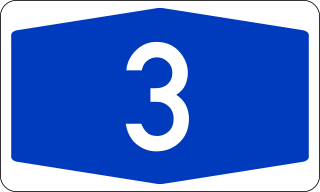
Bundesautobahn 3 is an autobahn in Germany running from the Germany-Netherlands border near Wesel in the northwest to the Germany-Austria border near Passau.
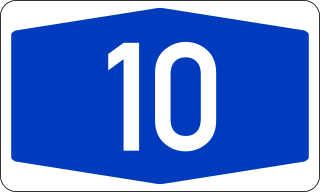
Bundesautobahn 10 is an orbital motorway around the German capital city of Berlin. Colloquially called Berliner Ring, it is predominantly located in the state of Brandenburg, with a short stretch of 5 km in Berlin itself. It should not be confused with the Berliner Stadtring around Berlin's inner city.

The Bundesautobahn 995 – short form: Autobahn 995 is an autobahn near Munich in southern Germany. It connects the southwestern parts of Munich with the A 8 and A 99. It is around eleven kilometers long and has two lanes and hard a shoulder in each direction.
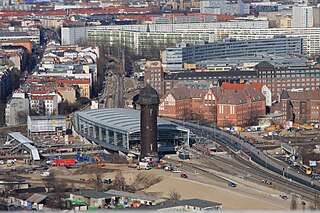
Berlin Ostkreuz is a station on the Berlin S-Bahn suburban railway and the busiest interchange station in Berlin. It is in the former East Berlin district of Friedrichshain, now part of the borough of Friedrichshain-Kreuzberg. A smaller part of the station is in Rummelsburg, part of the borough of Lichtenberg. The station is a Turmbahnhof with the Berlin–Frankfurt (Oder) railway and the Prussian Eastern Railway on the lower level and the Berlin Ringbahn on the upper level. It is used by a total of around 235,000 passengers every day on eight lines, entering or leaving.
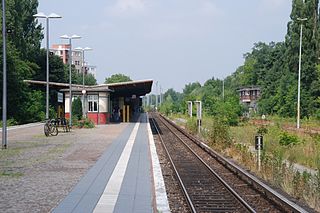
Berlin-Schönholz railway station is a railway station in Berlin, Germany. It is located on the Berlin Northern Railway line in the district of Reinickendorf, though it is named after the adjacent Schönholz quarter of the neighbouring Pankow district. From here, the Kremmen Railway branch line leads to Hennigsdorf and Kremmen. The station is served by S-Bahn trains and local bus lines, and is protected as a listed monument.
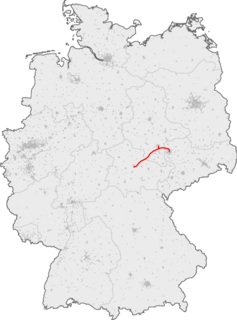
The Erfurt–Leipzig/Halle high-speed railway is a 123 km-long high-speed line in Germany between Erfurt and Leipzig and Halle.

The Frankfurt–Mannheim high-speed railway is a planned German high-speed railway between Frankfurt am Main and Mannheim.
German developments that employ green building techniques include:
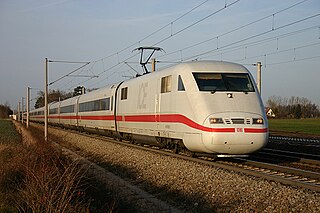
The Munich–Augsburg line connects Munich and Augsburg in the German state of Bavaria. It was built by the Munich-Augsburg Railway Company and opened in 1840. It was nationalised in 1846 and extended to Ulm in 1854. The line between Augsburg and Munich is a major traffic axis and part of the Magistrale for Europe from Budapest through Vienna to Paris.

The Hildesheim–Brunswick line is a 43 km long electrified main line railway in the German state of Lower Saxony. It forms part of the Intercity-Express route from Frankfurt to Berlin. It is also used as a diversion route from the Hanover–Brunswick line. It is a single track line from Hildesheim to Groß Gleidingen. A proposal to duplicate the line was included in the Federal Transport Infrastructure Plan of 1992.

The Berlin–Görlitz railway is a main line railway in the German states of Berlin, Brandenburg and Saxony, which was originally built and operated by the Berlin-Görlitz Railway Company. The line runs through Lusatia from Berlin via Cottbus to Görlitz. It is one of the oldest lines in Germany, opened in 1866 and 1867.

The Neustrelitz–Warnemünde Railway is a railway line in the North German state of Mecklenburg-Vorpommern. Most of the line is a double-tracked, electrified main line and runs for almost 130 kilometres from Neustrelitz to Warnemünde. It is also known in German as the Lloydbahn, referring to the Deutsch-Nordischer Lloyd company, which built the line and operated it in its early years after its opening in 1886.
The Kreuz Oranienburg is a partial cloverleaf with a semi-direct link in the German state Brandenburg in the Metropolitan region of Berlin.

The Schönefelder Kreuz is a cloverleaf interchange, with a direct link Magdeburg-Berlin and also a direct link Frankfurt (Oder)-Dresden, in the German state of Brandenburg in the metropolitan region of Berlin-Brandenburg.

The Dreieck Karlsruhe is a half-stack interchange in the German state of Baden-Württemberg.
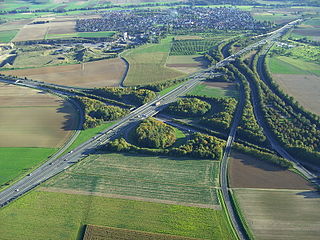
The Gambacher Kreuz is a cloverleaf interchange in Hesse, Germany where the A5 Autobahn from Basel to Bad Hersfeld intersects the A45 between Dortmund and Aschaffenburg. It constitutes a node in the primary route between the Rhein-Main metropolitan area and the eastern end of the Ruhr valley.

The Hermsdorfer Kreuz is a cloverleaf interchange in the German state Thuringia.

Bundesautobahn 36 is an autobahn in Germany. It was established on 1 January 2019 from the Bundesautobahn 395 and parts of the Bundesstraße 6.

The German Unification Transport Projects or German Unity Transport Projects, commonly known by their German initials VDE, are a set of major construction projects to increase and improve transport links between Eastern and Western Germany after German reunification. These projects are planned to positively impact regional development and infrastructure in the new federal states and across the inner German border.

















